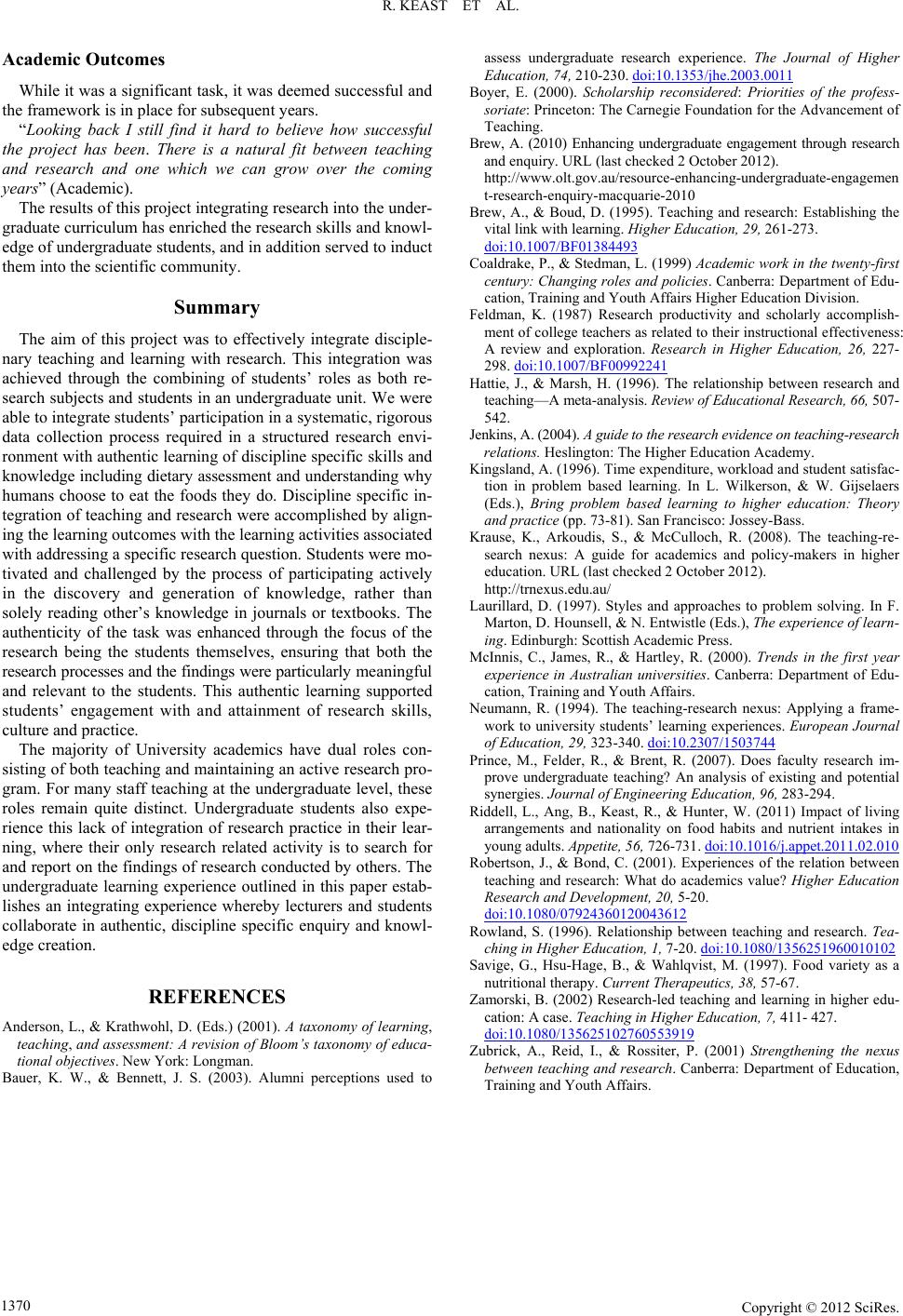
R. KEAST ET AL.
Copyright © 2012 SciRe s .
1370
Academic Outcomes
While it was a significant task, it was deemed successful and
the framework is in place for subsequent years.
“Looking back I still find it hard to believe how successful
the project has been. There is a natural fit between teaching
and research and one which we can grow over the coming
years” (Academic).
The results of this project integrating research into the under-
graduate curriculum has enriched the research skills and knowl-
edge of undergraduate students, and in addition served to induct
them into the scientific community.
Summary
The aim of this project was to effectively integrate disciple-
nary teaching and learning with research. This integration was
achieved through the combining of students’ roles as both re-
search subjects and students in an undergraduate unit. We were
able to integrate students’ participation in a systematic, rigorous
data collection process required in a structured research envi-
ronment with authentic learning of discipline specific skills and
knowledge including dietary assessment and understanding why
humans choose to eat the foods they do. Discipline specific in-
tegration of teaching and research were accomplished by align-
ing the learning outcomes with the learning activities associated
with addressing a specific research question. Students were mo-
tivated and challenged by the process of participating actively
in the discovery and generation of knowledge, rather than
solely reading other’s knowledge in journals or textbooks. The
authenticity of the task was enhanced through the focus of the
research being the students themselves, ensuring that both the
research processes and the findi ngs were particularly me an ing ful
and relevant to the students. This authentic learning supported
students’ engagement with and attainment of research skills,
culture and practice.
The majority of University academics have dual roles con-
sisting of both teaching and maintaining an active research pro-
gram. For many staff teaching at the undergraduate level, these
roles remain quite distinct. Undergraduate students also expe-
rience this lack of integration of research practice in their lear-
ning, where their only research related activity is to search for
and report on the findings of research conducted by others. The
undergraduate learning experience outlined in this paper estab-
lishes an integrating experience whereby lecturers and students
collaborate in authentic, discipline specific enquiry and knowl-
edge creation.
REFERENCES
Anderson, L., & Krathwohl, D. (Eds.) (2001). A taxonomy of learning,
teaching, and assessment: A revision of Bloom’s taxonomy of educa-
tional objectives. New York: Longman.
Bauer, K. W., & Bennett, J. S. (2003). Alumni perceptions used to
assess undergraduate research experience. The Journal of Higher
Education, 74, 210-230. doi:10.1353/jhe.2003.0011
Boyer, E. (2000). Scholarship reconsidered: Priorities of the profess-
soriate: Princeton: The Carnegie Foundation for the Advancement of
Teaching.
Brew, A. (2010) Enhancing undergraduate engagement through research
and enquiry. URL (last c he c ke d 2 O ct ob e r 2012).
http://www.olt.gov.au/resource-enhancing-undergraduate-engagemen
t-research-enquiry-macquarie-2010
Brew, A., & Boud, D. (1995). Teaching and research: Establishing the
vital link with learning. Higher Education, 29, 261-273.
doi:10.1007/BF01384493
Coaldrake, P., & Stedman, L. (1999) Academic work in the twenty-first
century: Changing roles and policies. Canberra: Department of Edu-
cation, Training and Youth Affairs Higher Education Division.
Feldman, K. (1987) Research productivity and scholarly accomplish-
ment of college teachers as related to their instructional effectiveness:
A review and exploration. Research in Higher Education, 26, 227-
298. doi:10.1007/BF00992241
Hattie, J., & Marsh, H. (1996). The relationship between research and
teaching—A meta-analysis. Review of Educational Research, 66, 507-
542.
Jenkins, A. (2004). A guide to the research evidence on teaching-research
relations. Heslington: The Higher Education Academy.
Kingsland, A. (1996). Time expenditure, workload and student satisfac-
tion in problem based learning. In L. Wilkerson, & W. Gijselaers
(Eds.), Bring problem based learning to higher education: Theory
and practice (pp. 7 3 -81). San Francisco: Jossey-Bass.
Krause, K., Arkoudis, S., & McCulloch, R. (2008). The teaching-re-
search nexus: A guide for academics and policy-makers in higher
education. URL (last checked 2 October 2012).
http://trnexus.edu.au/
Laurillard, D. (1997). Styles and approaches to problem solving. In F.
Marton, D. Hounsell, & N. Entwistle (Eds.), The experience of learn-
ing. Edinburgh: Scottish Academic Press.
McInnis, C., James, R., & Hartley, R. (2000). Trends in the first year
experience in Australian universities. Canberra: Department of Edu-
cation, Training a nd Youth Affairs.
Neumann, R. (1994). The teaching-research nexus: Applying a frame-
work to university students’ learning experiences. European Journal
of Education, 29, 323-340. doi:10.2307/1503744
Prince, M., Felder, R., & Brent, R. (2007). Does faculty research im-
prove undergraduate teaching? An analysis of existing and potential
synergies. Journal of Engineering Education, 96, 283-294.
Riddell, L., Ang, B., Keast, R., & Hunter, W. (2011) Impact of living
arrangements and nationality on food habits and nutrient intakes in
young adults. Appetite, 56, 726-731. doi:10.1016/j.appet.2011.02.010
Robertson, J., & Bond, C. (2001). Experiences of the relation between
teaching and research: What do academics value? Higher Education
Research and Development, 20, 5-20.
doi:10.1080/07924360120043612
Rowland, S. (1996). Relationship between teaching and research. Tea-
ching in Higher Education, 1, 7-20. doi:10.1080/1356251960010102
Savige, G., Hsu-Hage, B., & Wahlqvist, M. (1997). Food variety as a
nutritional therapy. Current Therapeutics, 38, 57-67.
Zamorski, B. (2002) Research-led teaching and learning in higher edu-
cation: A case. Teaching in Higher Education, 7, 411- 427.
doi:10.1080/135625102760553919
Zubrick, A., Reid, I., & Rossiter, P. (2001) Strengthening the nexus
between teaching and research. Canberra: Department of Education,
Training and Youth Affairs.